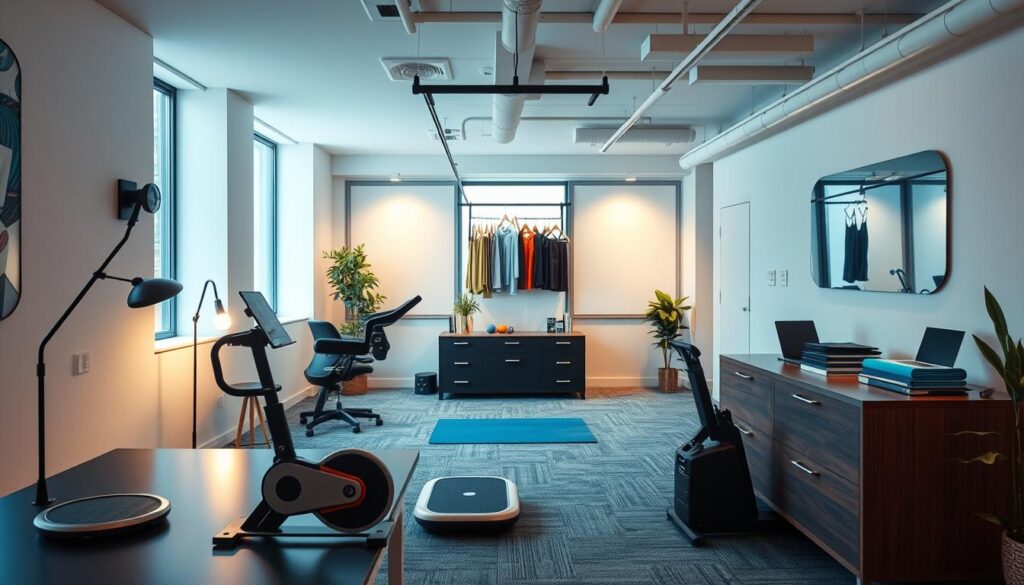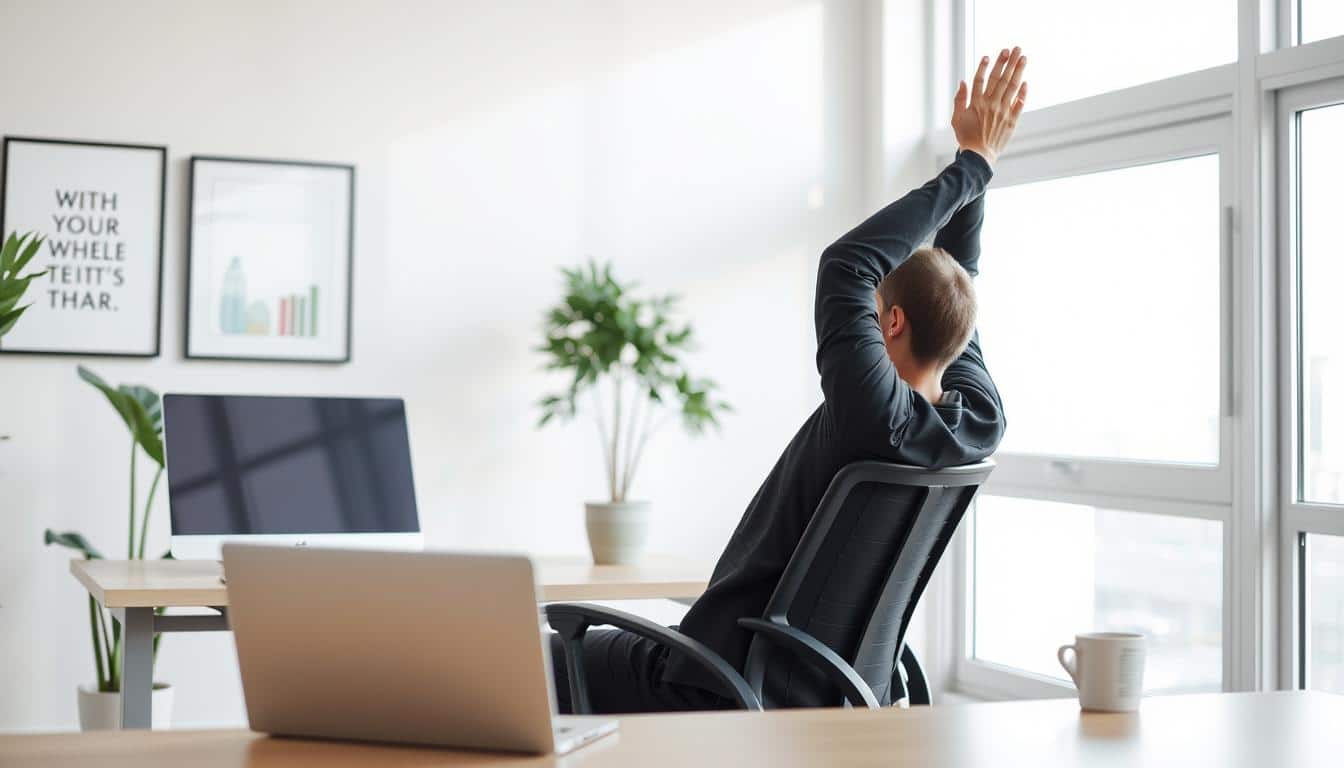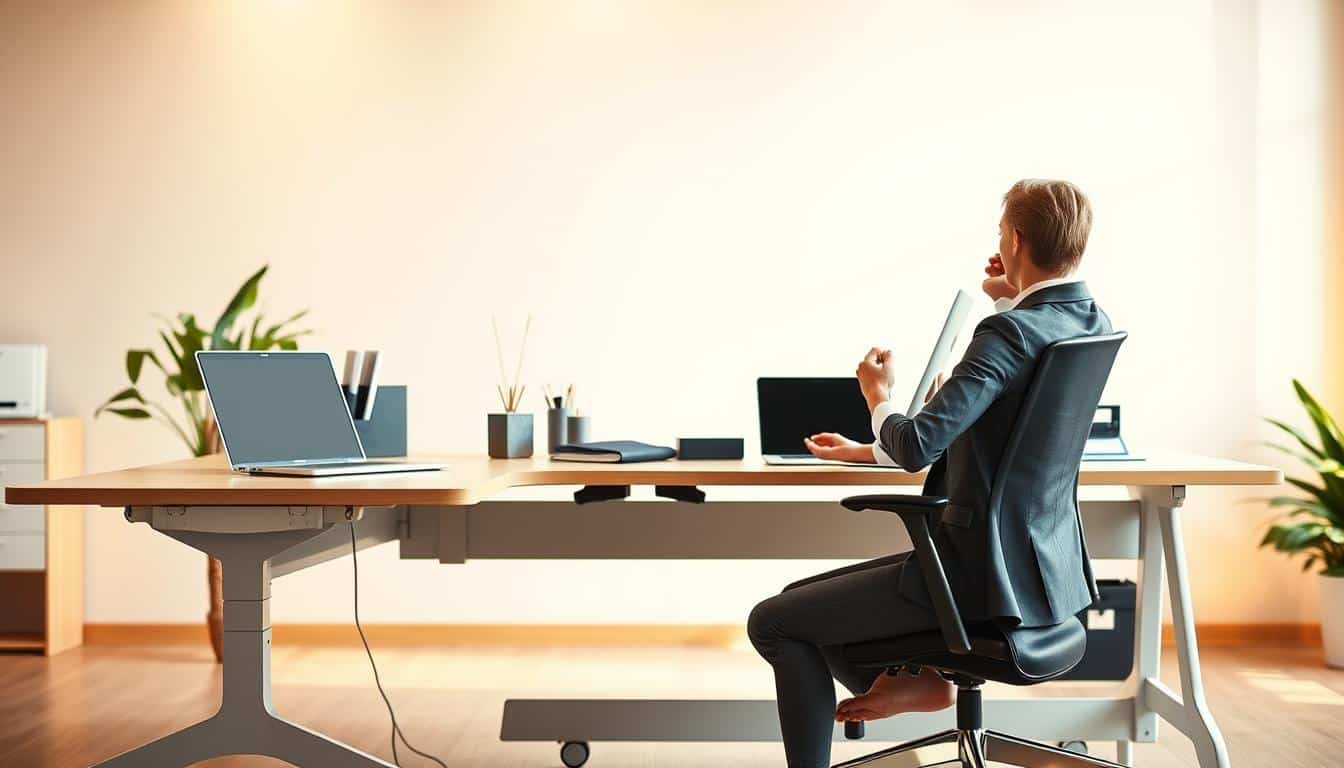In our fast-moving work world, desk office fitness is key for better health and happiness at work. Many people sit at their desks for hours, so adding physical activity to your day is crucial. Research shows that simple stretches and exercises can make you more productive, less stressed, and ease pain from sitting too long.
Being active not only boosts your health but also makes for a happier work environment. Studies find that stretching at work can cut pain by 72%, improve posture, and make everyone feel better. With the growing need for fitness at work, it’s important to find ways to stay active all day.
The Importance of Desk Office Fitness
Desk office fitness is key to better health and higher productivity for employees. Studies show that 45% of women and 30% of men stand for less than 30 minutes at work. This shows a big problem of inactivity at work. Moving regularly helps avoid issues like bad blood flow and stiff muscles.
Adding fitness to daily routines greatly improves physical and mental health. For example, doing aerobic exercises often makes the hippocampus bigger. This helps with learning and remembering things better. Such mental boosts are due to higher levels of a health-promoting molecule, which improves brain health.
Research says that walking on a treadmill while reading improves memory and focus. Even just one session of exercise can make memory better. Letting workers exercise during work or setting up fitness areas can make the workplace better. Giving resources like fitness app subscriptions and healthy snacks can motivate employees to be active.
Having a focus on desk office fitness makes employees happier. Physical activity releases endorphins, leading to relaxation and positivity. As a result, employees feel more energetic and more involved in their work. So, fitness is crucial for a productive work environment.
Health Risks of Sedentary Lifestyle
Living a sedentary life can majorly increase your health risks with long-lasting effects. Not being active enough can lead to obesity. This, in turn, sets the stage for serious conditions like diabetes and heart disease. Sitting for too long can make your muscles weaker, mess up your metabolism, and lead to brittle bones because they lose minerals.
Also, it can harm your blood flow and might cause hormone problems. This can lead to inflammation in your body.
There’s a clear link between sitting too much and getting chronic diseases. Heart disease, stroke, type 2 diabetes, and some cancers can come from not moving enough. Many people worldwide aren’t active enough, making these problems worse. For example, adults in the United States sit about 7.7 hours a day. This is worrying because it means there’s a bigger risk of dying from any cause and more chance of heart and metabolic diseases.
It’s really important to move more to be healthier. Just making small changes, like standing when you’re on the phone or using a stand-up desk, can help. You could also take the stairs or go for a short walk during your lunch break. These small steps can fight the bad effects of sitting too much. Knowing and dealing with these health risks is key to staying healthy, especially if you work at a desk all day.
Desk Office Fitness: Simple Exercises to Enhance Your Well-being
Adding desk exercises to your day can greatly improve your health and make the workplace more active. Even a few minutes of exercise can ease stress and make you more productive. Below are some easy exercises you can do right at your desk:
- Isometric Muscle Strengthening: Tighten and hold your muscles for 3-10 seconds, aiming to do this in 3 sets of 10.
- Oblique Twists: Work on your core and better your posture. For more challenge, hold weights.
- Desk Push-ups: Use your desk to do 10 push-ups and strengthen your upper body.
- Seated Leg Extensions: While sitting, stretch your legs out to work on your quads.
- Chair Calf Raises: Either standing or sitting, lift onto your toes to build calf muscle.
- Chair Squats: Lower down towards the chair and use weights for extra work.
- Arm Circles: Stretch your arms out and rotate them to tone your shoulders.
- Neck Swings: Move your head from side to side gently to reduce neck stiffness.
- Chair Dips: Use a chair to dip and lift yourself up to build arm strength.
- Desk Jumps: Do jumps with your feet apart at your desk and stand up straight again.
Doing these desk exercises can get your blood moving, cut down on tiredness, and clear your mind. Setting aside just 5-10 minutes for physical activity during work promotes a fit workplace culture. This leads to a healthier work setting overall.
Effective Stretching Techniques for Office Workers
If you work in an office, adding stretches to your daily routine can help a lot. Sitting too long makes us stiff and uncomfortable. So, it’s vital to stretch during the day. Doing neck rotations and wrist stretches can help ease tension and make you more flexible.
Wrist and Finger Stretches
Wrist and finger stretches are key to avoid pain from typing too much. Here are some good stretches to help you feel better:
- Gently extend one arm in front, palm up. With the opposite hand, pull back on the fingers to stretch the wrist. Hold for at least 15 seconds.
- Make a fist and then stretch all fingers wide, repeating several times to promote blood flow.
- Stretch your fingers by placing your palms flat on the desk, pressing down to elongate the fingers and wrists.
It’s also crucial to ease neck tension. Doing neck rotations can help get rid of stiffness and help you relax.
Sitting too much can lead to health issues like heart disease and diabetes. Experts recommend taking short breaks every 30-45 minutes to stretch. This includes doing shoulder stretches. Stand near a wall, lift your arm, and move it as if you’re drawing the hours on a clock. Do this on both sides to make your shoulders and chest more mobile.
Regular stretching keeps you flexible and more comfortable while working. Taking breaks to stretch can make you more productive and create a happier workplace.
Quick Workouts You Can Do at Your Desk
Adding quick workouts to your day at the desk boosts your fitness. These easy exercises take little time and won’t mess up your work. They give you an energy boost, make you feel happier, and fight off tiredness while you’re working.
Seated Leg Extensions
Seated leg exercises keep you moving when you’re at your desk for hours. Try the seated leg extension. Sit up straight, lift one leg until it’s level with the floor, then slowly lower it. Switch legs and keep going. This strengthens your thigh muscles and gets your blood flowing.
You can also do desk push-ups and calf raises easily. To do a desk push-up, put your hands on your desk edge and lower your body, keeping your stomach tight. Stand and lift your heels for calf raises. Hold it, then lower back down.
These quick exercises during breaks can really help you stay fit at work. They’re a good way to beat sitting all day in the office. Try to move around every hour. You can use a timer or apps to remind you to do these workouts.
The Benefits of Regular Movement at Work
Moving around at work brings many benefits for mind and body. It helps people who sit all day feel much better. Doing things like stretches or walking helps you focus, stay alert, and do better work.
Taking short breaks to stretch or walk around can make a big difference in your health. Try to move around when you’re on the phone. You could even use some weights or stretch bands at your desk. Moving around helps lower stress and keep stress hormone levels in check.
Moving around doesn’t just help your body right now; it helps over time too. Getting up and active can cut down on how often you’re sick by up to half. People also sleep better and feel more refreshed, which makes them do better at work. Moving more can also make you happier by releasing happy brain chemicals.
Being creative gets easier when you move around, especially with activities like walking. Adding movement into team activities can also improve teamwork and motivation. Regular exercise helps your brain work better and lowers the risk of heart disease and diabetes.
Encouraging movement during the workday helps to build a healthier work environment. Being active at work is key to staying well now and in the future.
Strategies for Staying Active Throughout the Day
Moving more during your workday can greatly improve your health and happiness. Using smart strategies at work means employees will take better care of their health. Making small changes can really help you be more active, even on busy days.
Use the Stairs Whenever Possible
Choosing stairs over elevators is a smart move. It’s a quick way to up your daily activity. Taking short walks every hour also helps. It cuts down on sitting too long, gets your blood moving, and clears your mind.
Businesses can play a big part in keeping everyone healthy. Some good ideas include:
- Hold walking meetings to combine collaboration with exercise.
- Incorporate stretching breaks at your desk to relieve tension in the neck, shoulders, and back.
- Perform bodyweight exercises like squats and lunges during brief breaks.
- Practice mindfulness and deep breathing exercises to combat stress.
- Shake your body for 30 seconds to boost energy levels.
- Utilize under-desk treadmills or resistance bands during calls to enhance activity.
Start with easy workouts and slowly make them harder to avoid injuries. Try to move more by walking during phone talks. Even tiny changes to your work area can create an active, health-first culture at the office.
Creating the Right Office Environment for Fitness
The office plays a key role in encouraging workplace fitness. Adding things like comfortable seating and productivity tools can turn a normal office into a place that supports being active. For instance, getting standing desks lets people choose to stand or sit, which helps avoid the downsides of sitting too long.
Incorporating Exercise Equipment
Adding workout gear to the office lets employees have quick exercise breaks. Key workout items like resistance bands, adjustable dumbbells, and compact treadmills that fit under a desk can be brought in. These choices are great for saving space and promoting physical activity. Depending on the space, fitness areas can be small or expand into full office gyms.
Lighter equipment, like yoga mats for core strengthening and foam rollers for relaxing muscles, can also be included without taking up too much space. With the right storage, keeping these tools tidy and within reach encourages everyone to use them during their free time.
To get more people involved in being active, think about flexible work hours and fun fitness challenges for everyone. Keeping an eye on things like gym use, how happy employees are, and their health can show the good things that come from focusing on fitness at work.

How to Stay Motivated for Desk Office Fitness
Staying motivated for fitness at work is tough but crucial for achieving goals. Creating a workout buddy system with coworkers works well. This partner helps keep you accountable and makes exercise fun and interesting.
Finding a Workout Buddy
A workout buddy system encourages team work and boosts motivation. Here’s how to start:
- Team-Based Fitness Bingo: Use GoJoe’s app for various fitness tasks with coworkers, promoting teamwork and friendly competition.
- Virtual Yoga Sessions: Hold group yoga to improve mental and physical health. GoJoe tracks attendance, building a community feeling.
- Charity-Based Fitness Challenges: Aim for fitness milestones that benefit charities, with GoJoe showing progress and community impact.
- Mindfulness Monday Challenges: Start the week with guided meditations from GoJoe, helping with stress and focus.
- Deskercise Challenges: Encourage desk-time exercises like chair squats. GoJoe keeps track, making sure everyone can join.
- Monthly Fitness Challenges: Create monthly themes with GoJoe’s help. This offers ongoing motivation and celebrates successes.
- Rewards and Prizes: Drive engagement with rewards, tracked and awarded by GoJoe.
Using these methods and GoJoe’s app, employees can keep up their fitness momentum. This leads to a healthier office. As motivation grows, working out together can become a shared, enjoyable journey.
Desk Office Fitness Equipment Recommendations
Choosing the best fitness tools for your office is vital for your health and work performance. Using the right desk office fitness equipment boosts your physical health and keeps you focused. Stability balls and resistance bands are great for small spaces.
Stability Balls
Stability balls are a versatile fitness tool for office workers. They help you work your core muscles by sitting on them instead of regular chairs. These balls improve your posture and balance.
Using a stability ball makes your core muscles work harder. Adding resistance bands to your routine makes your workout even better. You can exercise different muscle groups this way.
- Choose a ball that lets you adjust how firm it is.
- Try different exercises like wall squats or seated bounces for a complete workout.
- A 65 cm ball is ideal for people 5’7″ to 6’0″ tall.
Stability balls make exercising at work easy and beneficial. They help you stay active and focused while doing your job. Adding this equipment to your office can bring many health benefits.
Tips for Preventing Injury While Exercising at Your Desk
Adding exercise to your office routine is great for your health. However, it could be risky if not done right. Keeping safe is key, especially since musculoskeletal problems make up nearly 40% of all workplace injuries in the U.S., costing about $50 billion each year. Using the right techniques and knowing your limits helps keep you safe. This way, you can enjoy office fitness to the fullest.
Start with dynamic stretches to make your joints more flexible and your muscles more efficient. This lowers the chance of getting hurt when you do harder exercises. Desk workers should try wrist counter-stretches, turning their necks 180 degrees, and rolling their shoulders. These exercises prevent injuries by helping you keep a good posture and a straight spine.
- Wrist counter-stretches
- Tennis ball squeezes
- Desk presses
- Seat squats
- Thumb stretches
- Standing lunges
- Toe touches
- Tricep stretches
Choose exercises that help avoid injury, like shoulder rotations, hip stretches, and glute bridges. These strengthen your joints and muscles, which is very helpful for desk workers. Watch videos to learn the correct way to do these exercises. This helps prevent common injuries to the rotator cuff and lower back.
The NASM’s Corrective Exercise Continuum offers great advice on how to exercise properly. This helps reduce pain and improve how your body works. Focusing on the right technique is not just about safety. It also leads to a healthier and more active workplace.
Conclusion
In our world today, adults sit for 6 to 8 hours a day. Making time for fitness at your desk job is a must to stay healthy at work. Sitting too much can lead to serious health problems like heart disease, diabetes, and other issues. To fight this, simple exercises such as squeezing your shoulder blades, lifting your legs, and taking short walks can make a big difference in your health.
Adding quick, powerful workouts to your day, like doing jumping jacks or climbing stairs, can also boost your fitness. Companies that support fitness see less staff leaving and fewer sick days. They also notice more creativity and better work from their team. Encouraging regular movement and providing tools to help can lead to a happier and healthier team.
Knowing what makes people want to exercise at work can improve fitness programs. Research shows that being active helps you think clearer. Now is the time for businesses to start health programs that show they care about their team’s well-being. Even small, regular steps toward fitness can change health for the better. This leads to a more lively and effective workplace.



